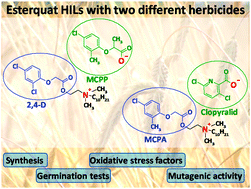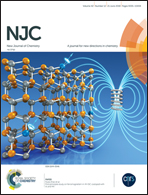Esterquat herbicidal ionic liquids (HILs) with two different herbicides: evaluation of activity and phytotoxicity†
Abstract
Herbicidal ionic liquids (HILs) constitute a new concept in crop protection products. Their main advantage is the potential to combine the efficiency of traditional herbicides with low vapour pressure and adjustable water solubility which leads to improved environmental safety in the agricultural sector. Among many strategies to obtain new HILs, esterquats seem to be well suited for modification since both the cation and anion may be constituents of herbicides. In the framework of this study 16 new esterquat HILs were synthetized based on standard herbicides: 2,4-D, MCPA, MCPP, 4-CPA, Clopyralid and Dicamba. Germination tests performed on agricultural soil using cornflower indicated the best two HILs. Furthermore, analysis of the toxicological effects of HILs on wheat plants revealed an additional advantage of the two selected HILs. The glutathione (GSH) content and glutathione S-transferase (GST) activity showed a lower oxidative stress level in wheat plants treated with examined HILs, respectively, in comparison to a mixture of reference compounds. Finally the Ames test was applied in order to analyse the mutagenic activity of the two selected HILs.



 Please wait while we load your content...
Please wait while we load your content...